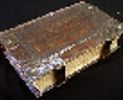
Tarore was from the Ngati Haua iwi. Her father was Ngakuku, nephew of the great Te Waharoa, and chief of the Ngati Haua of Tainui.
A.N.Brown and his wife Charlotte opened a mission station in April 1835 in Matamata on a site provided by Te Waharoa. Tarore attended their mission school, she learned to read doing so well she was awarded a prize - one of the first Gospels of Luke printed in New Zealand, in Te Reo (Maori Language).
In October 1836, hearing a war was coming the decision was made to send the children to safety in Tauranga. Ngakuku and the CMS missionary John Flatt left with them heading over the Kaimai Range. The first night they made camp at Wairere Falls, but the camp fire attracted an ememy raiding party. After a brief fight the enemy withdrew. But 12 year old, Tarore was dead, killed in her sleep, her heart cut from her body and her copy of St Luke's gospel taken. Her death immediately created a desire for utu (revenge), but Tarore had read her gospel to her father and Jesus had worked in his heart. He carried home his daughter's body and at the Tangi said there had been too much bloodshed already and that the people should trust in the justice of God.
Uita of Rotorua, who killed Tarore took her gospel thinking it was of value because she wore it in a special treasure bag around her neck. A slave named Ripahau, taught to read at the mission station, then freed, stopped at Uita's pa on his way home. He read it to Uita and his people. Uita was so convicted by the Holy Spirit he decided he must seek forgiveness of Tarore’s father, knowing his life was forfeit as utu. It was a dangerous journey, any one of Tarore's relatives could have killed him on sight. But he found Ngakuku and then Jesus as Ngakuku lead him in the sinner’s prayer and they were reconciled.
Given some pages from Tarore’s Gospel, Ripahau carried them to Otaki, where he met Tamihana Te Rauparaha from Kapiti Island, the son of Wiremu Te Rauparaha, the great Ngati Toa chief. Ripahau read them to Tamihana and his cousin Matene Te Whiwhi. He taught them to read and once again Luke’s gospel touched hearts, all three became Christians. A messenger was sent back to Rotorua for more books. The book that was returned to them, now somewhat worn, was the remainder of Tarore's book. Tamihana and Matene took Tarore’s book with them to the South Island, preaching the gospel of peace and reconciliation. When Bishop Selwyn visited the South Is. in 1842, before European settlers arrived, he found much of the Maori population were Christian.
Tarore is buried at Waharoa. Her grave regularly visited, her story and that of her father, Ngakuku and her gospel of Luke is a treasure of the church in Aotearoa.
BORN:1824,
New Zealand.
DIED: 19 October 1836,
Wairere Falls, Kaimai Range, New Zealand.
 Welcome
Welcome Calendar
Calendar Today's Word
Today's Word Lauds
Lauds Terce
Terce Sext
Sext None
None Vespers
Vespers Compline
Compline Matins
Matins